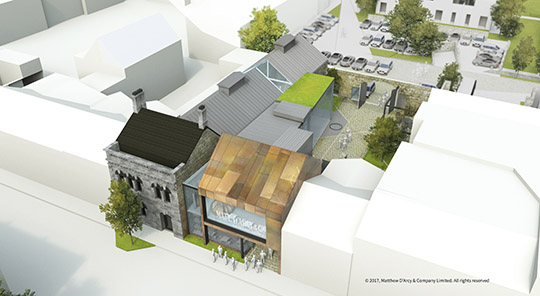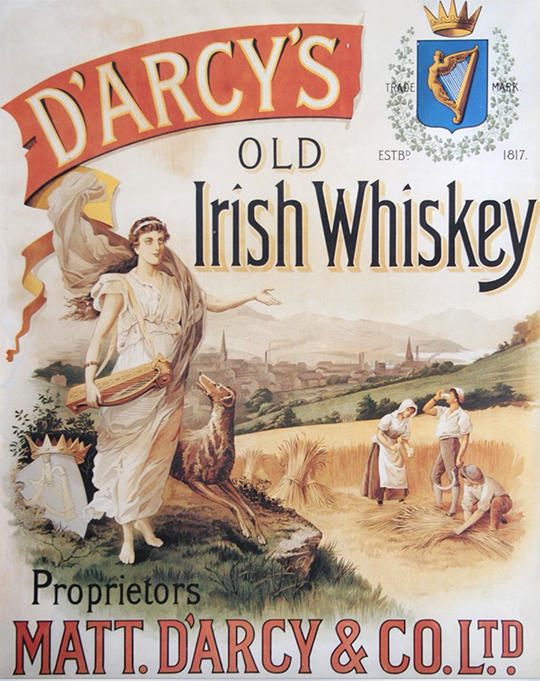Michael McKeown, a Newry entrepreneur, has re-opened an old Newry whiskey distillery adding an economic and tourism boost for the Newry area.
Across Ireland there has been a growth in whiskey and gin distilling along with a growth in craft beers, and now Newry is to have a distillery with a real keg-full of history.
In addressing guests at the launch, he welcomed everyone to the Old Newry Distillery and announced the rebirth of Old Newry Whiskey.
Speaking at the launch, he said: “There is evidence that the legal distillation of spirits in Newry was happening before 1600.
“Eminent historian Jonathan Bardon writing in the ‘The Plantation of Ulster’ states that when Arthur Bagenal inherited the town of Newry in 1603, ‘The town had to be largely rebuilt as a result of an accidental fire, caused by a whiskey distiller, in 1600.’
“It is further recorded in the Rent Roll of the Town of Newry in the year of 1575 that there existed “The queen’s back-house and Brewhouse.” Further research might reveal that the tradition of distilling was begun in the Cistercian Monastery which preceded the town of Newry. We may certainly be a contender for the oldest legal distillery in Ireland.

“The earliest available newspaper records for the eighteenth reveal advertisements for ‘Newry Whiskey’ ranking only behind Dublin whiskey in prominence. The distilling businesses operating in Newry before 1800 were Chapman, D’arcy, Caulfield and Thompson. Chapman put his working distillery up for sale in 1802 and we know that in 1817 all of these other parties were acting in partnership on two sites in Newry and this site is one of those original sites.”
Michael explained that to honour the last distiller who occupied this site, he has resurrected the title of Matthew D’arcy & Company Ltd. I was born into the wines and spirit blending, bottling and distributing business in Lurgan in 1946. Our environment was one of bottles to be washed, barrels to be decanted, the smell of whiskey, rum and wines.
“Even when we moved to a bungalow in the country in 1952, when the well failed, my father brought home water in old wine or whiskey barrels. I am reminded of the saying of St Ignatius of Loyola who said, ‘Give me the child until he is seven and I will give you the man.’ So, my apprenticeship in my formative years qualifies me if nothing else does.”
He added: “Surprisingly I am quite a teetotaller myself, but I remained actively in the wines and spirits industry until the age of 30 and thereafter as a shareholder in the family business of Reihill-McKeown Ltd which was absorbed into the C&C Group in 1995. One of my earliest memories of my father is waiting patiently for my pocket money while he completed the proof testing of whiskey that he was blending.
“I then came to live in Newry in 1995. An added bonus to me was the rich history of the area and I quickly became deeply interested in researching. This led to my publication of ‘The Book of Newry’ in 2007. Whilst preparing that I was delighted to find details on the wonderful entrepreneurs of the 19th century who are responsible for all the principal buildings of the city. So when in 2014 I found it easy to uncover the threads of the histories of the whiskey distillers, blenders and bonders who maintained the position of Newry Whiskey in Ireland, England, the USA and even Australia.
“In December 2015 I was privileged to be elected as President of Newry Chamber of Commerce and Trade. My first action was to embrace the economic and tourism plan of the Newry Mourne & Down District Council and indeed I consider the carrying out of this project is an exercise in mirroring the objectives in that plan. The objectives are:
- To regenerate derelict areas in town centres;
- To create tourist attraction;
- To increase exports;
- To provide employment;
- And to support the cultural arts.
“We are extremely well placed to be an important stop on the Irish Whiskey Trail being developed by Tourism Ireland half-way between Belfast and Dublin and no more than 5 minutes from the M1 Motorway. We are very happy that we have acquired the services of Mr Tom Heneghan, resident in this area but formally of Bord Failte and one of the founding participants in the creation of Tourism Ireland.

“It was very clear that if I were to revive the great tradition of distilling in Newry that it had to be on one of the original sites. Matthew D’arcy & Company Ltd acquired this site on 5th February this year. This is the original location of Matt D’Arcy in 1817. We immediately progressed with surveying and architectural study.
“We were so fortunate to have acquired the services of Alina Holyst, RIBA Chartered Architect and Urban Planner, Director at PLACE NI and occasional lecturer at Queen’s University Belfast. That phase has been completed with the depositing of our planning application with the Newry Mourne & Down District Council yesterday afternoon. You will shortly be able to explore the site and view the architectural plans.
“It is our intention to restore the early nineteenth century buildings and within these buildings provide a working distillery, a visitor’s centre, restaurant and an authentic Victorian public house. The site also allows for an open courtyard and a passageway from busy Monaghan Street to the Council carpark at Corry Square. On the upper floor will be a small theatre space for multiple uses, such as the Visitor Experience, private functions and local theatre and film groups.”
Michael also explained that it was his intention to produce around 9000 cases per year of single malt and to retain stocks for at least 10 years to obtain premium prices. “We will now intensify our efforts to recruit a master distiller of ability and reputation to achieve that target.
“In the intervening years, we will market blends of purchased whiskey from other sources under the very attractive brand names which we have registered and which are all inherited from previous occupants of this site, such as Duncan, Alderdice & Company LTD. These brands are: The Blackthorn, The Native, Hand-in-Hand and Killeavey Cream. It will be timely to announce more definite plans after our planning permission has been granted.”


























